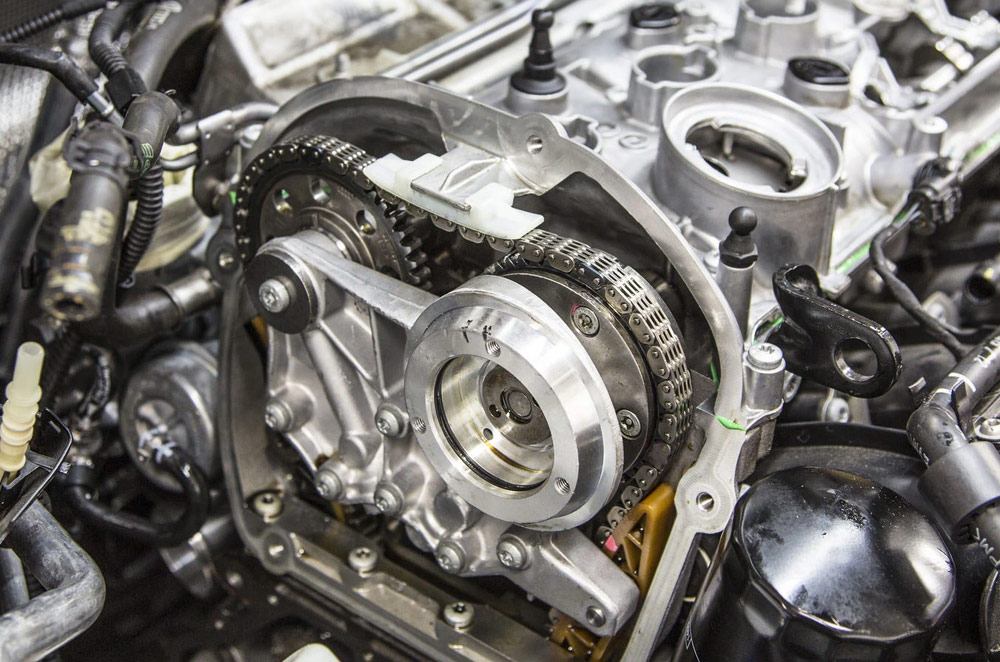
The timing chain, much like a pacemaker, ensures that everything in your engine runs smoothly and efficiently. This chain allows all motor components to work in sync with one another and stops them from damaging or running into other components in the engine. One missed step could throw everything off balance.
That said, as the timing chain is a crucial part of your vehicle’s engine, making sure that it is in top condition is a priority and is an important part of your vehicle’s maintenance process. With that said here is a quick guide to understanding what a timing chain is what it does in relation to the engine of your vehicle.
What is a timing chain?

It is a metal chain that takes power from the engine to drive the camshaft. Compared to its rubber belt counterpart, it is much quieter and lighter, and relatively maintenance-free. Aside from this, timing chains are also known for their longevity and durability as these do not have to be changed as often as their rubber-based timing belt counterpart. These will also often last the lifetime of a car with a minimal need for maintenance.
What does a timing chain do?

In a similar fashion to what a timing belt does, a timing chain synchronizes the position of the pistons and camshafts of an engine. It ensures that the motor has the proper timing and allows the engine’s valves to open and close in accordance with the combustion process of an engine. The chain is located inside the motor and requires to be well lubricated at all times in order to prevent wear and tear.
When should a timing chain be replaced?

As this part lasts longer than a timing belt these will be changed between the 120,000 to 150,000-kilometer mark of a vehicle. However, this will still depend on the engine and the specifications of the manufacturer. It is also important to keep the timing chain well lubricated as using the wrong viscosity oil could damage the timing chain pins and plates.
It is important to note that while a timing chain is more durable than a timing belt signs of it stretching or failing are slightly harder to detect. It’s also harder to make a timing chain jump teeth causing the engine to go out of sync. Here is a quick list of signs to look out for which indicate that it could be time to replace a timing chain.
-
The engine misfires or runs poorlyThis could indicate that the timing is off with the engine as the valves aren’t properly in sync with one another and could leave a small gap in between the combustion process.
-
Metal shavings are found in the oilA good way to detect if a chain is failing is by looking at the oil in the engine via an oil change. If there are metal shavings found in the oil it could be an indication that the timing chain has been stretched and is on its way out. However, it could also be a sign of something else, so keep that in mind when inspecting the oil.
-
The engine refuses to start or fails to idle A broken or damaged timing chain will not allow the engine to start or will have it fail while driving. If this happens your engine may skip its timing and the pistons may come in contact with the valves leading to a serious repair and impairing the movement of your vehicle.
-
The check engine light is onAnother indicator of a stretched or a damaged timing chain is the check engine light. The vehicle’s computer will display this warning light only if it detects something is wrong with the car. If its sensors detect something is wrong then the light will turn on requiring immediate attention and a scan to be conducted to get to the root of the problem.
-
Abnormal rattling sounds from the engine while idling
One auditory way to find out if your timing belt is failing is to listen for unusual rattling noises. A normal engine should have a consistent and smooth sound indicating that everything is running as it should. When a timing chain becomes stretched it will cause vibrations inside the engine that will produce a rattling sound as it idles.
What can I expect from a timing chain replacement?

When your timing chain needs to be replaced it will require the engine to be opened up or even removed from the vehicle itself. Aside from the costly repair bill for the parts and labor, also expect downtime for the car as this process may take a few days to complete. It is important to note that it will also depend on the availability of the service center as well. Aside from the initial process of replacing the timing chain, expect to have a short break-in period for your vehicle as well to see if everything is running as it should. This is done to check if the installation process was done correctly and if anything else will need to be addressed afterward.
Latest Features
-
Tire tread patterns: What they are and why they matter to your car / Tips & Advice
Tire tread patterns aren’t just for looks; they also determine traction, handling, and overall performance on the road.
-
Five things to check on your car before driving during the rainy season / Featured Article
Planning to drive in the rain? Make sure to inspect these five vital parts of your car before hitting the road.
-
What we can expect from the upcoming Mitsubishi Destinator / Featured Article
The Destinator debuts this July 23, and according to Mitsubishi, it’s more than just an XForce with extra seats.
Popular Articles
-
Cheapest cars under P700,000 in the Philippines
Jerome Tresvalles · Sep 02, 2024
-
First car or next car, the Ford EcoSport is a tough package to beat
Jun 18, 2021
-
Car Maintenance checklist and guide – here’s everything you need to know
Earl Lee · Jan 12, 2021
-
Most fuel efficient family cars in the Philippines
Bryan Aaron Rivera · Nov 27, 2020
-
2021 Geely Okavango — Everything you need to know
Joey Deriquito · Nov 19, 2020
-
Family cars in the Philippines with the biggest trunks
Sep 20, 2023
-
Head to head: Toyota Rush vs. Suzuki XL7
Joey Deriquito · Oct 28, 2020
-
Why oil changes are important for your car
Earl Lee · Nov 10, 2020
-
2021 Kia Stonic — What you need to know about it
Joey Deriquito · Oct 16, 2020
-
Top 7 tips for buying a used car in the Philippines
Joey Deriquito · Nov 26, 2020



